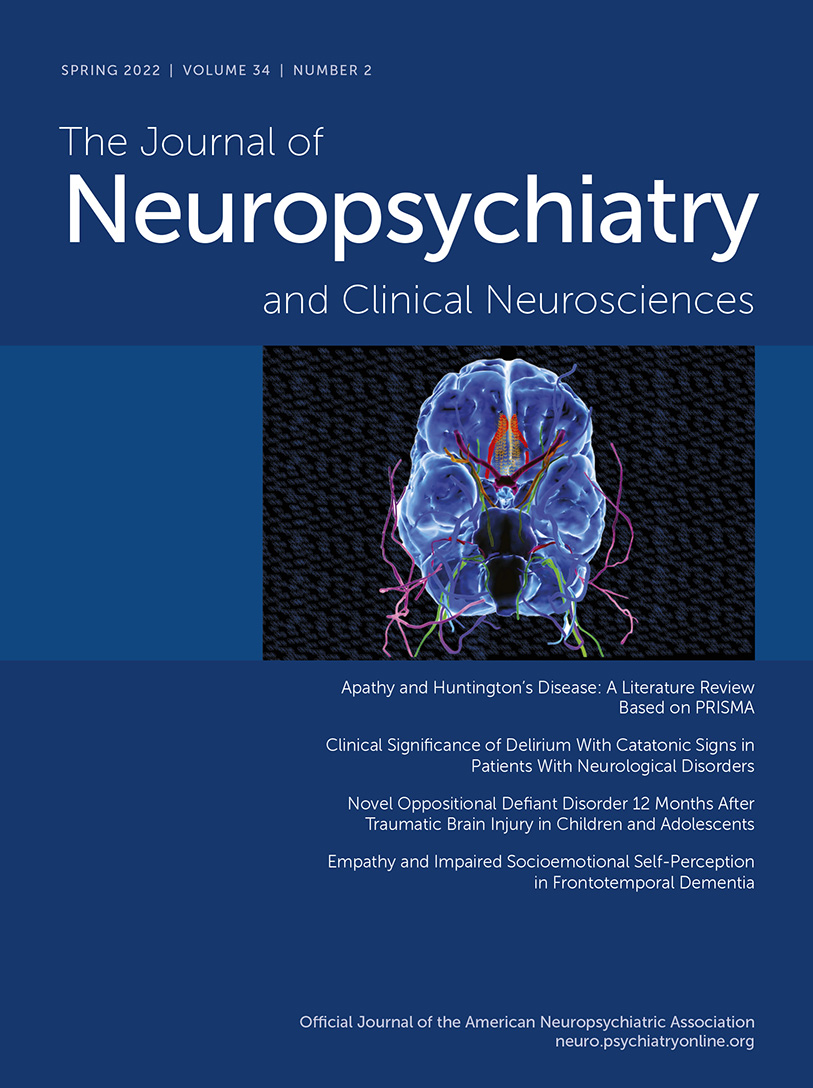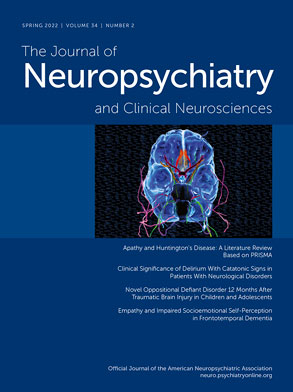Behavioral variant frontotemporal dementia (bvFTD) is a progressive neurodegeneration of the frontal and anterior temporal lobes that usually presents with behavioral changes, including loss of empathy (
1). bvFTD, the second most common dementia among patients older than 65 years old (
2), is unique in that it is the only neurological disorder in which loss of empathy is a core diagnostic feature. Among patients with bvFTD, alterations in empathic behavior range from lack of warmth or consideration for others, to lack of responsiveness to the concerns of loved ones, to frankly sociopathic acts and questionable moral behavior (
1,
3).
Investigators can study bvFTD to unravel the underlying mechanisms of empathy. Empathy is the sharing of an emotion that is isomorphic with another’s emotion, but in reference to oneself (
4). The construct of empathy includes cognitive components to identify what others feel and think, such as perspective taking and Theory of Mind, and emotional components for responding with an appropriate emotion, such as affect sharing. The definition of empathy also includes directing and co-representing someone else’s perceived emotions onto oneself (
5). Empathic thinking about how others feel includes self-consciousness about how one might feel in their situation.
Indeed, in addition to impaired cognitive and affective empathy (
3,
6–
8), the other major emotional impairment in bvFTD occurs in self-conscious emotions (
9), which require someone to incorporate another’s perceived appraisals and beliefs, as exemplified by embarrassment and shame. Further evidence of lack of self-conscious behaviors among patients with bvFTD is their decreased self-monitoring of their behavior to ensure that it is consistent with how others expect them to behave (
10). Therefore, both empathy and self-conscious behavior require self-perception in social or interpersonal situations.
Investigating self-perception can clarify the neurological basis of impairments in empathy. Although previous studies have strongly suggested a relationship between loss of empathy and impaired self-awareness or self-consciousness among people with bvFTD (
11,
12), they have not directly studied their association. This exploratory study proposes a relationship between the loss of empathy and impaired socioemotional self-perception not due to the general effects of dementia as with the prototypical dementia of Alzheimer’s disease. We used research intake interviews and available behavioral scales to investigate well-characterized patients with bvFTD in comparison with those with Alzheimer’s disease. In addition to caregiver scales, self-report scales are included as a further indication of the patients’ insight into their socioemotional behavior, another aspect of self-perception (
13).
Methods
Participants
The patients with bvFTD and Alzheimer’s disease underwent a comprehensive dementia evaluation. The participants with bvFTD (N=25) met clinical criteria for probable bvFTD on the basis of the International Consensus Criteria for bvFTD (
1). The clinical diagnosis of probable bvFTD was confirmed by the presence of predominant frontal and anterior temporal involvement on structural or functional neuroimaging. The comparison group of patients with early-onset Alzheimer’s disease (age at onset <65 years) (N=25) met National Institute on Aging-Alzheimer Association guidelines for probable Alzheimer’s disease, including changes consistent with Alzheimer’s disease-compatible neurodegeneration on neuroimaging (
14). The patients had Montreal Cognitive Assessment (MoCA) scores (
15) indicating comparable impairment, and they had participating caregivers. They were on standard-care medication for dementia, with no psychoactive medications except sertraline, citalopram, or escitalopram. As part of a larger study, these patients underwent an extensive intake interview, which included yes-or-no questions that are part of the Insight Inventory questionnaire (
16). This study was approved by the institutional review board at the University of California, Los Angeles.
Behavioral Measures
Socioemotional Dysfunction Scale (SDS).
On the 40-item SDS (maximum score, 200), caregivers rate items regarding the patient’s current lack of empathy (in contrast to premorbid empathic behavior) on a 5-point Likert scale (
16). The 40 items are summed, yielding a total raw score. This scale has demonstrated the ability to discriminate bvFTD from Alzheimer’s disease and has an internal consistency of α=0.98 (
17). Examples of items are “Is not interested in and concerned about others,” “Does not go out of his/her way to help others,” “Does not express concern or provide comfort when others experience sadness or loss,” and “Does not reciprocate expressions of warmth after receiving the consideration of others.”
Self-consciousness questions from research intake interview.
On initial presentation, caregivers were asked to complete an extensive interview with questions that included items reflecting self-conscious traits. Ten questions were extracted from the intake interview and rated on a scale ranging from 0 to 2 for each of the following items (maximum score, 40): whether the patient had impaired self-awareness of their emotions in social situations and whether the patient had a decreased ability to experience that emotion in general. Specific emotions included anger at self, embarrassment, envy, fear of being laughed at, guilt or remorse, jealousy, pride, shame, shyness, and sense of being disrespected.
Schutte Self-Report Emotional Intelligence Test (SSEIT).
The SSEIT (
18) is a 33-item questionnaire (maximum score, 180) that assesses the capacity to perceive one’s emotions and to handle interpersonal relationships empathetically. Patients rate their perceived ability on a 5-point Likert scale. The average or mean of all items is computed to provide an overall score, which resulted in adequate reliability among this sample (α=0.81). Examples of items on the SSEIT include “By looking at their facial expressions, I recognize the emotions people are experiencing” and “When another person tells me about an important event in his or her life, I almost feel as though I have experienced this event myself.”
Embarrassability Scale (EMB).
The EMB (
19) is a 36-item scale (maximum score, 180) in which patients are asked to imagine themselves in embarrassing situations and record their level of embarrassment or self-consciousness on a 5-point Likert scale. Patients are asked to imagine these situations as vividly as possible and whether the situation would cause them embarrassment, including self-consciousness, awkwardness, discomfort, or a sense of social exposure. Examples of items are “Suppose you go to pay at a restaurant and find that you did not bring your purse or wallet” and “Suppose that, while laughing heartily with a group of friends, you pass gas.”
Statistical Analysis
A complete power analysis was not conducted for this pilot or preliminary exploratory study; however, a power analysis from prior results from the SDS (α=0.05; β=0.80) indicated that 25 patients per group was more than sufficient (β=0.44) (no differences anticipated for SSEIT and EMB) (
17,
19,
20). Next, these characteristics and the behavioral scale results were compared between the groups using chi-square (Yates correction for scales) and t tests for categorical and continuous variables, respectively, plus Pearson’s correlations for the behavioral measures.
Results
No statistically significant differences were observed between groups on demographic variables or the MoCA (
Table 1). On the Patient Insight Inventory items, the patients with bvFTD differed significantly from the patients with Alzheimer’s disease on the item related to concern over others’ seeing or perceiving them differently, but did not differ significantly on the other items.
Group comparisons showed significant differences in SDS scores and the self-consciousness questions, with the patients with bvFTD performing worse than the patients with Alzheimer’s disease (
Table 2). The results from the SDS indicated that the patients with bvFTD were more impaired than the patients with Alzheimer’s disease (
16), and they had less self-consciousness, as reported by their caregivers. On both the SSEIT and the EMB, the patients with bvFTD rated themselves as having good functioning compared with the patients with Alzheimer’s disease and with the performance of normal controls reported in the literature (
19,
20). Across groups, the only significant correlations were between scores on the SDS and the self-consciousness questions (r=−0.945; p<0.0001) (
Table 2).
Discussion
This pilot study suggests that impaired empathy depends on socioemotional self-perception. The patients with bvFTD, who were observed to lack empathy and self-conscious behavior, could not correctly see themselves in interpersonal contexts or embarrassing situations. On caregiver assessments, their observed loss of empathy was strongly correlated with observed loss of self-conscious emotions, suggesting that the measures were assessing very related constructs. In addition, patients’ self-reports of emotional intelligence and embarrassability were inconsistent with caregiver reports and indicated a loss of insight into how others see or perceive them. Together, these findings support the hypothesis that impairment in self-consciousness in social settings contributes to impaired empathy among people with bvFTD.
The ability to direct feelings at oneself is necessary for empathy. This requires perceiving the emotion of another and co-registering and self-referring it to one’s own emotional system (
21,
22). The regions involved in both empathy and self-referential or self-conscious emotions greatly overlap in the brain. For example, experiencing pain empathy and pain are both related to activity in the anterior insulae and the anterior cingulate cortex, whereas alexithymia and reduced empathy are both related to hypoactivation of the anterior insulae (
23). BvFTD precisely targets the anterior insulae, the anterior cingulate cortex, and other empathic behavioral centers of the brain, such as the ventromedial prefrontal cortex (
24), which has a key role in mediating the social affective and self-referential processes that inform one’s sense of self (
25).
This pilot study has limitations. First, these data were not specifically collected to test this hypothesis and were collected as part of a larger socioemotional study of bvFTD. These findings should lead to a larger hypothesis-driven study. Second, the study does not establish causation, but it does suggest a link between empathy and caregiver assessments of impaired social self-perception. Third, this study included two self-report questionnaires, measures that are limited in ecological validity when applied to patients with bvFTD (
13). These scales, however, showed that, when compared with patients with Alzheimer’s disease, the lack of self-insight displayed by patients with bvFTD was specifically worse when they were asked how others may see or perceive them. Finally, the authors cannot exclude potential effects of executive or other deficits on empathy and self-perception, and a larger study with neuropsychological measures is needed.
Although preliminary, this report emphasizes that empathy is not about others so much as it is about oneself. Patients with bvFTD fail to model the emotions of others onto themselves as a result of neuropathology involving the anterior insulae, anterior cingulate cortex, and ventromedial prefrontal cortex. This has clinical implications for interventions, ranging from instructional to biofeedback, that target increasing patients’ subjective awareness to increase their empathy for others.

